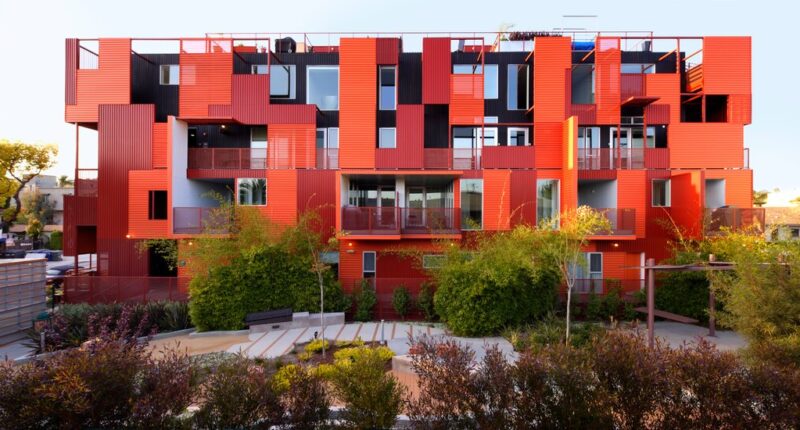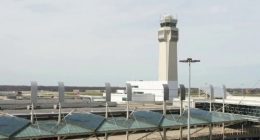
In 1991, Frances Anderton was a young journalist newly arrived in Los Angeles, when she parked herself in a one-bedroom unit in a building codesigned by Frank Gehry. The 1960s stucco apartment house in Santa Monica had an overhanging red roof and wide, wooden balconies, something like a cross between a bungalow motel and a Japanese minka. Early in his career, Mr. Gehry lived there with his family. At one time or another, so did his sister, his psychoanalyst and the artist Judy Chicago.
Ms. Anderton, who grew up in England, became a longtime producer and host of radio programs about design and architecture for KCRW in Los Angeles. But she skipped the itchy, transitory habits of many Americans, for whom a first apartment is a gateway to a single-family house.
In the course of dating Robin Bennett Stein, a musician and writer she ultimately married, she made room for him in her apartment. After the couple had a daughter, they traded up to a two-bedroom in the same building (the unit that once belonged to Mr. Gehry’s analyst).
And there they remain. “During the years I lived by myself, I felt safe, tucked between neighbors; later, our only child grew up in a building where she never felt alone,” Ms. Anderton writes in her recent book, a paeon to community living called “Common Ground: Multifamily Housing in Los Angeles.”
In “Common Ground,” Ms. Anderton, 60, makes the point that while Los Angeles may seem like a sprawling breeding ground of American dream houses set in gardens, it has an equally compelling history of shared real estate that continues to this day.
Perpetual sunshine has allowed the city’s multifamily housing to be opened to courtyards and parks and festooned with exterior staircases and balconies, breaking the stolid blocks of traditional apartment houses and fostering social connections. And while most of these buildings’ forms and arrangements have been transplanted from other regions — like Angelenos themselves — they bear the creative claw marks of the architects who came to Southern California to test their imaginations: health-seeking humanists like Irving Gill, radical modernists like Rudolph Schindler and form-manipulating mavericks like Mr. Gehry.
As contemporary architects and developers work to relieve Los Angeles of its vicious housing scarcity — almost 42,000 people in the city are currently unhoused — “Common Ground” shows examples of affordable multifamily buildings that look like anything but.
Real estate development is never a walk in the park, but because some relief from the city’s draconian restrictions is granted to creators of affordable housing, this area has attracted design innovators working with progressive developers who are committed to righting decades of inequities created by exclusionary housing policies. For this reason, many of the projects that “Common Ground” highlights make the most out of the least: those with oddly shaped lots, peripheral locations and components produced in factories.
One example: MLK1101, a 26-unit, mixed-use complex for formerly homeless veterans and low-income families, which delivers sunlight, greenery and a balance of communal and private space without sacrificing feelings of security. Designed by Lorcan O’Herlihy with the nonprofit development agency Clifford Beers Housing (now Holos Communities), and completed in 2019, the energy-efficient building has a green roof that swoops to the ground at its entrance — a gesture, one critic pointed out, that may be familiar in cultural buildings but is rarely seen in affordable housing.
“Our job is to produce solutions, not just objects,” Mr. O’Herlihy said. Which is not to diminish the importance of curb appeal. By designing attractive buildings that dignify a block, he helps stave off the resistance of neighbors.
Mr. O’Herlihy works to give access to green space however he can find it. In the case of Formosa 1140, an 11-unit, market-rate condominium built in 2009 in West Hollywood, the project’s economics did not allow for a central courtyard, so his developer partners negotiated with the city to lease a piece of the lot as a pocket park that could be enjoyed by both residents and the public.
Currently, his office is completing Isla Intersections, an affordable housing complex on a wedge-shaped median between two roads in South Los Angeles. From this unpromising site have risen stacks of factory-built steel modules punctuated by little green spaces. Each of the 57 modules is a one-bedroom unit, and one of the bordering streets is being turned into a paseo — a public pedestrian thoroughfare with landscaping that will help clean the air.
Squeezing not just housing but an entirely new building type from the margins is an achievement “Common Ground” highlights in its discussion of One Santa Fe. Described by Ms. Anderton as “a skyscraper laid on its side,” the three-block-long building, which opened in 2011, combines 438 apartments, 20 percent of them affordable, with shops, restaurants, a bookstore and multiple communal areas, including a pool deck.
The surroundings and air quality are not exactly pastoral, given that One Santa Fe runs alongside Metro rail tracks in the city’s newly developed arts district. “There was very little there,” the architect, Michael Maltzan, recently recalled. “You would see tumbleweeds blow across the street. I’m not making that up.”
There were no real precedents in Los Angeles for the building’s scale and high level of mixed use, he noted. Facing down criticism that the size would overwhelm the neighborhood, he looked ahead, trying to envision how the city would evolve around it. For instance, One Santa Fe was designed to provide access to an anticipated Metro Red Line station. If that emerges, the complex — most of which floats like a bridge over the street level — will turn into a gateway between transit and the city.
The building has attracted a hybrid group of residents of various ages and income levels, offering “an alternative to the binary housing split in Los Angeles — apartments for the poor or young and old people without children, and houses for well-to-do families,” Ms. Anderton writes. And it has proved to be a bellwether for similar bulked-up developments in other neighborhoods.
Larry Scarpa, a partner in the architecture firm Brooks + Scarpa, said he believes the future of housing in Los Angeles lies in combining affordable and market-rate units under a single roof. His firm recently completed a mixed-use development called 11NOHO that took advantage of a California state bill allowing for increased height and density in buildings with affordable units (12 out of 60, in this case). The building is on the edge of an emerging arts district in North Hollywood with “a lot of restaurants and shops that need service industry workers,” he said. “Why should they drive from Palmdale,” a city more than 50 miles away?
The design, a variant of the courtyard apartment style identified with Los Angeles for more than a century, is characteristic of two earlier Brooks+Scarpa projects featured in “Common Ground”: The Six, a 2017 supportive housing building for disabled veterans, and the Rose Apartments, a 2022 mixed-use complex for young adults who have aged out of child-welfare facilities and foster homes. These buildings all wrap around communal outdoor spaces that connect visually to the street, but offer the feeling of light-filled sanctuaries.
Ms. Anderton said she was motivated to cheerlead for multifamily housing when her daughter, who was in high school, complained of feeling stigmatized by living so differently from her friends in single-family houses.
But when she embarked on her book, she recalled, “People would say, ‘Frances, you’ve got to remember people so desperately want to own a home.’”
She was reminded of the racial history that carpeted Los Angeles with single-family zoning, providing financial assets for white families and driving renters of color to the margins.
“All absolutely true,” Ms. Anderton said. “But that doesn’t mean that this other story isn’t true, too. We really have to treasure our multifamily housing history.”
Living Small is a biweekly column exploring what it takes to lead a simpler, more sustainable or more compact life.
For weekly email updates on residential real estate news, sign up here.
Source: | This article originally belongs to Nytimes.com









